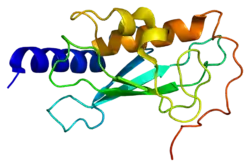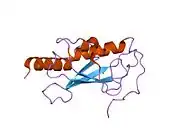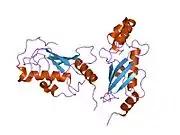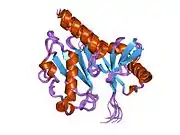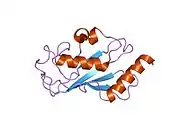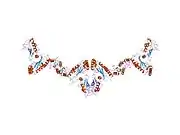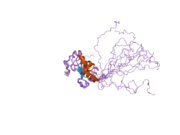Kua-UEV
Ubiquitin-conjugating enzyme E2 variant 1, also known as Kua-UEV, is a human gene.[3]
The Kua-UEV mRNA is an infrequent but naturally occurring co-transcribed product of the neighboring Kua and UBE2V1 genes.[4] Ubiquitin-conjugating E2 enzyme variant proteins constitute a distinct subfamily within the E2 protein family. They have sequence similarity to other ubiquitin-conjugating enzymes but lack the conserved cysteine residue that is critical for the catalytic activity of E2s. Two alternative transcripts encoding different isoforms have been described. The proteins produced by these transcripts have UEV1 B domains but the proteins are localized to the cytoplasm rather than to the nucleus. The significance of these co-transcribed mRNAs and the function of their protein products have not yet been determined.[3]
References
- GRCh38: Ensembl release 89: ENSG00000124208 - Ensembl, May 2017
- "Human PubMed Reference:". National Center for Biotechnology Information, U.S. National Library of Medicine.
- "Entrez Gene: Kua-UEV ubiquitin-conjugating enzyme E2 variant 1".
- Thomson TM, Lozano JJ, Loukili N, Carrió R, Serras F, Cormand B, et al. (November 2000). "Fusion of the human gene for the polyubiquitination coeffector UEV1 with Kua, a newly identified gene". Genome Research. 10 (11): 1743–56. doi:10.1101/gr.gr-1405r. PMC 310942. PMID 11076860.
Further reading
- Long M (November 2000). "A new function evolved from gene fusion". Genome Research. 10 (11): 1655–7. doi:10.1101/gr.165700. PMID 11076848.
- Bonaldo MF, Lennon G, Soares MB (September 1996). "Normalization and subtraction: two approaches to facilitate gene discovery". Genome Research. 6 (9): 791–806. doi:10.1101/gr.6.9.791. PMID 8889548.
- Rothofsky ML, Lin SL (August 1997). "CROC-1 encodes a protein which mediates transcriptional activation of the human FOS promoter". Gene. 195 (2): 141–9. doi:10.1016/S0378-1119(97)00097-8. PMID 9305758.
- Sancho E, Vilá MR, Sánchez-Pulido L, Lozano JJ, Paciucci R, Nadal M, et al. (January 1998). "Role of UEV-1, an inactive variant of the E2 ubiquitin-conjugating enzymes, in in vitro differentiation and cell cycle behavior of HT-29-M6 intestinal mucosecretory cells". Molecular and Cellular Biology. 18 (1): 576–89. doi:10.1128/mcb.18.1.576. PMC 121525. PMID 9418904.
- Xiao W, Lin SL, Broomfield S, Chow BL, Wei YF (September 1998). "The products of the yeast MMS2 and two human homologs (hMMS2 and CROC-1) define a structurally and functionally conserved Ubc-like protein family". Nucleic Acids Research. 26 (17): 3908–14. doi:10.1093/nar/26.17.3908. PMC 147796. PMID 9705497.
- Ma L, Broomfield S, Lavery C, Lin SL, Xiao W, Bacchetti S (September 1998). "Up-regulation of CIR1/CROC1 expression upon cell immortalization and in tumor-derived human cell lines". Oncogene. 17 (10): 1321–6. doi:10.1038/sj.onc.1202058. PMID 9771976.
- Hofmann RM, Pickart CM (March 1999). "Noncanonical MMS2-encoded ubiquitin-conjugating enzyme functions in assembly of novel polyubiquitin chains for DNA repair". Cell. 96 (5): 645–53. doi:10.1016/S0092-8674(00)80575-9. PMID 10089880. S2CID 17117789.
- Deng L, Wang C, Spencer E, Yang L, Braun A, You J, et al. (October 2000). "Activation of the IkappaB kinase complex by TRAF6 requires a dimeric ubiquitin-conjugating enzyme complex and a unique polyubiquitin chain". Cell. 103 (2): 351–61. doi:10.1016/S0092-8674(00)00126-4. PMID 11057907. S2CID 18154645.
- Thomson TM, Lozano JJ, Loukili N, Carrió R, Serras F, Cormand B, et al. (November 2000). "Fusion of the human gene for the polyubiquitination coeffector UEV1 with Kua, a newly identified gene". Genome Research. 10 (11): 1743–56. doi:10.1101/gr.GR-1405R. PMC 310942. PMID 11076860.
- Dias DC, Dolios G, Wang R, Pan ZQ (December 2002). "CUL7: A DOC domain-containing cullin selectively binds Skp1.Fbx29 to form an SCF-like complex". Proceedings of the National Academy of Sciences of the United States of America. 99 (26): 16601–6. doi:10.1073/pnas.252646399. PMC 139190. PMID 12481031.
- Guo D, Han J, Adam BL, Colburn NH, Wang MH, Dong Z, et al. (December 2005). "Proteomic analysis of SUMO4 substrates in HEK293 cells under serum starvation-induced stress". Biochemical and Biophysical Research Communications. 337 (4): 1308–18. doi:10.1016/j.bbrc.2005.09.191. PMID 16236267.
